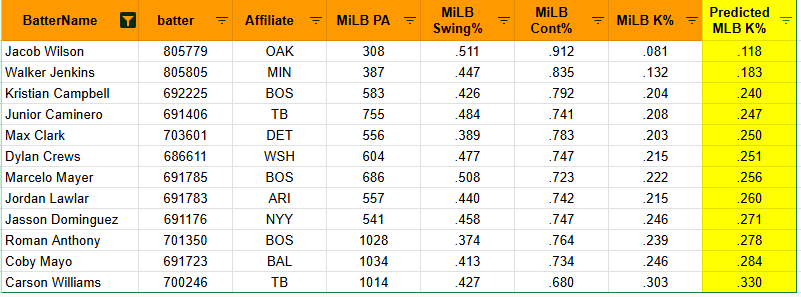One of the keys to grabbing the right prospect hitters is to get the guys who can manage the strikeout rate upon first reaching the Major Leagues. The better we can be at identifying those hitters, the better we’ll do in fantasy baseball.
I didn’t want to devote a ton of time to this, but I did enough to share. I went back to 2023 and found hitters with time (300+ PA) in both the minors and Majors so I could compare the two.
I grabbed minor league data:
→ K%
→ Swing%
→ Contact%
And then, of course, their MLB K%. I used these data points to build a couple different prediction models. Nothing fancy, just linear regression stuff.
The average K% jump from the minors to the Majors is about 22%. You can do half-decent just by multiplying a player’s minor league K% by 1.22 and predicting that. But we can do a little better if we use all three of the data points above. Minor league swing and contact rates aren’t very easy to find, but you can find them on my tools - and they’re becoming more and more available as people like me put tools together.
I don’t want to get into the model details, and I don’t want to claim like this is the best we can do. I’m sure other people out there have more complex models that do a better job than me. But here is the linear model:
MLB K% Prediction = (0.479) + (Swing% * -0.2017) + (Contact% * -0.33101) +(K% * 0.5336)
Let’s take an example. Jacob Wilson played a good bit in the minors from 2023-2024 and did this:
Swing%: 51.1%
Contact%: 91.2%
K%: 8.1%
Plus those numbers into the formula and you get 11.7%. His MLB K% last year in 103 PAs was 9.7%. Pretty close.
I’ll give you one list of players for free and then give paid subs access to the full data (I predicted MLB K% for more than 1700 minor league hitters, and you can filter it by team).
Here are some of the game’s top hitting prospects:
This is great news for Kristian Campbell, whose predicted value is strong at 24%. For his teammate Roman Anthony, things are a bit worse at 27.8%.
Let’s hit the paywall and then paid subs can have the link to the full data set.





